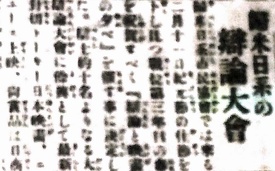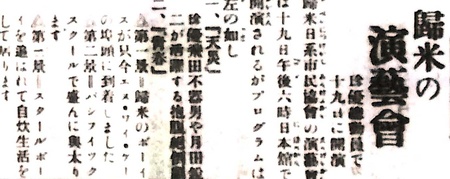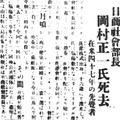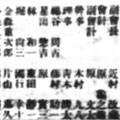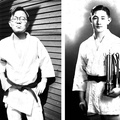Activities of the Kibei JACL
“Nikkei Cooking Classes” (August 28, 1934 issue)
The female department of the Kibei JACL will have Japanese cooking classes at Nikkoro every Thursday starting in September.
Some sources state that this female department of the Kibei JACL was formed at the extraordinary general meeting which was held two weeks after the establishment of the Kibei JACL in 1932.
“Fall Great Performance Show by Kibei Nikkei” (October 28, 1935 issue)
The Kibei JACL will have a great performance show at the Japan Hall on November 3. The program is as follows: 1. Donna-konna (“what kind of”) story (two-act comedy), 2. Dance, English sketch, 3. Yakuza-jingi (“duty”) (historical play of the three acts and four scenes), 4. Kibei Nikkei choice, new dance, chorus (Kibei Nikkei female department), shakuhachi, shamisen ensemble, 5. violin performance (by Morita’s disciple), banjo performance, solo singing, tap dance, shakuhachi, koto (Japanese harp) ensemble, 6. Comedy “You’re Mine”
“Kibei Nikkei New Board Members” (October 4, 1938 issue)
The Kibei JACL conducted the re-election of its board members and new members have been selected: chairperson Mitsuyuki Yanagida, vice chairperson Minoru Mihara, managers Rei Kikuchi, Minoru Iguchi, Nobuyoshi Kano, Taeko Ninoue, Tamiko Okano, secretary Mieko Kawaguchi, accountant Yoshikazu Furukawa, advisers Terumitsu Kano, Iwao Kaida, Yukio Kunimoto, Koichiro Kurokawa, and Yoshito Harada.
According to the 100th anniversary issue of The North American Post in the fall of 2002, advisor Terumitsu Kano was a Kibei Nisei who came back to Seattle after graduating from the old-system junior high school in Japan in 1930, and worked as Editor-in-Chief at The North American Post until 1959.
“Kibei Nikkei General Meeting” (October 14, 1938 issue)
The Kibei JACL will hold its extraordinary general meeting at 1 p.m. on November 16 at the Japan Hall following its great performance show. They ask for attendance of all members. Now, since they will be hosting an ice-skating party after the meeting at Ballade with an aim to promote fellowship among its members, they expect all members to receive free admission tickets at the office during the general meeting.
“Speech Contest of Kibei Nikkei” (January 17 & 27 and February 4 & 7, 1939 issues)
The Kibei JACL has decided to host “Speeches and Film Night” on February 11 in celebration of Kigensetsu (Empire Day) and to honor the third year of the Second Sino-Japanese War . . . Ten speakers, including a blind Kibei young male and a female studying abroad have been chosen and announced:
Mitsunori Yanagida, Haruo Yanagida, Rei Kikuchi, Minoru Miyake, Kiyoko Kamazuki, Yoshio Kaida, Ai Seni, Kanichi Iwami, and Hideo Ohta. . . .
The contest judges are Sumiyoshi Arima (President of The North American Times), Kenji Ito (Student Club), Terumitsu Kano (The North American Times), Toshio Nakamura (Manager of Youth Branch at Nihonjin-kai), Yoshitaro Fujihira (Manager of Educational Branch at Nihonjin-kai), Kunizo Maeno (former chairperson of Nihonjin-kai) and Nobuyuki Murano.
The following retail stores in the community have donated prizes: Mitsuwado, Sagamiya, Tazuma Ten-Cent Store, Asahi Garage, Gyokkoken, Nikko-ro, Kinka-ro, Main Street Service Station, Nishimoto-shoten, North Coast Trading Company, West Cost Printing Office, Kashiwagi Clothing Store, Jackson Shoes Store, Chihara Clock Store, Koba Retail Store, Umbilo Café, Jackson Café and Evergreen Turban.
For this speech contest volunteers from Nihonjin-kai and those in Seattle like Sumiyoshi Arima served as the judges. The January 27 issue reports that the first-place trophy was awarded from Nihonjin-kai to the winning speech. Many retail stores in Japan Town made donations, too, which shows that the Japanese residents in Seattle were all supportive of the Kibei JACL’s activities.
“Kibei Nikkei’s Outdoor Party” (June 10, 1939 issue)
The Kibei JACL has decided to have its regular picnic on the 18th (Sun.) at Mizuno’s villa at Crystal Springs on Bainbridge Island. The tickets (50 cents for ferry and bus fares) have already been on sale. The event will be held rain or shine with a ferry planned to leave Colman Dock at 8 a.m. for Winslow where a connecting nonstop bus will be waiting. There will be a variety of competitions and also some other activities such as tennis, table tennis, swimming, rowing, and dance at night. With plenty of prizes and refreshments available, they expect a lot of people – regardless of their membership – to come by getting the tickets mentioned earlier.
“General Meeting of Kibei” (September 15, 1939 issue)
The fall general meeting will be held on the 17th at the Nissho Hall. Re-election of board members and other things are planned. They expect members to attend.
“Kibei’s Performance Show” (September 27 and November 1 & 15, 1939 issues)
A fund-raising performance show will be held at the Japan Hall on November 19, and part of the donations will be sent to Nissho’s year-end relief fund. The program includes comedy, tales of wanderers, the sketch Seishun (The Spring of Life), and others. The admission fees are 40 cents for adults, 25 cents for students and 15 cents for children. . . .
The first scene of the sketch Seishun spotlights Kibei boys just arriving at the dock of SYK. The second scene shows them with delinquent behavior at Pacific School. The third scene depicts them cooking their own meals as they lost their job of being schoolboys.
This play titled Seishun is presumably based on the reality of the life of Kibei Nisei in America; the Kibei Nisei characters arrive at the Port of Seattle, go to Pacific School, but eventually quit school and begin looking after themselves as they find it difficult to keep up with classes.
“Roundtable Discussion of Kibei” (December 8, 1939 issue)
The Kibei JACL will host a year-end roundtable discussion at 2 p.m. at the Nissho Hall on the 10th which is aimed at promoting fellowship and improvement of relationships among its members. They are hoping that Kibei Nikkei non-member citizens will attend, too, in addition to its members. They are planning to have some entertainment after the session.
“The Speeches and Film Nights by the Kibei JACL” (March 27, 1940 issue)
Given the success of “The Speeches and Film Night” held on Empire Day last year the Kibei JACL has decided to host the same event at the Japan Hall at 8 p.m. on May 4 (Sat.) again this year. They are currently recruiting speakers: to be qualified one must be a Kibei Nikkei citizen, but other than that, anyone can apply regardless of gender with a seven-minute speech. Those who wish to apply should contact the new office of the peer committee (1045 Main St.) or Kano at the main office. The judges will be announced once decided and the featured film will be Tokai no Kaoyaku (“The boss of Tokai”).”
My Kibei Nisei Father
My father Atae was a Kibei Nisei. However, his background was a bit different from a typical Kibei Nisei’s. Atae was born in Seattle in 1914 and had dual citizenship in the U.S. and Japan. In 1921, he moved to Japan at the age of seven and went to Japanese elementary school for three years.
He re-entered the U.S. before the enforcement of the Immigration Act of 1924, entered a public school in the city of Walla Walla, and transferred to another public school in the city of Seattle in 1928.
In 1929, however, he moved to Japan again because of his father Yoemon’s sudden death and went to junior high school and college in Japan. He dropped out of college in 1935 and returned to the U.S. and worked as a train attendant for Alaska Railroad in Seattle until February 1941. He eventually went back to Japan, however, as his family in Japan strongly insisted on his return due to concerns about the danger of a Japan-U.S. War.
Thus Atae moved back and forth between Japan and the U.S. and because of this background he was fluent in both English and Japanese and sufficiently understood the lives and cultures of two countries. However, he was confronted with the tragedy that was the war and faced the end of his life as an elementary school teacher on an island on the Seto Island Sea in Japan unable to exercise his skills to the fullest. (For details, please read the series Yoemon Shinmasu – Life of My Grandfather in Seattle)
Summary
I would imagine that Kibei Nisei, since they moved to Japan at a young age despite being born in the U.S. and spending a long time in Japan had a hard time adapting to American culture and learning English. We can clearly see that under these circumstances the Kibei JACL hosted a number of events to play the role of a mediator to connect them to Japan, introduced Japanese cultures, and did their very best for the integration of members in the Nikkei community.
In the next chapter, I will introduce articles on the Japan Observation Group of Nisei Girls that visited Japan for the first time around 1939.
References
Kojiro Takeuchi, Beikoku Seihokubu Nihon Imin-shi (History of Japanese Immigrants in the Northwestern United States), Taihoku Nippo-sha, 1929.
Consulate-General of Japan in Seattle, History of Nikkei in Washington, Consulate-General of Japan in Seattle, 2000.
Edited by Zaibei nihonjin-kai jiseki hozonbu, History of the Japanese in the U.S., Zaibei nihonjin-kai in the U.S., 1940.
*The English version of this series is a collaboration between Discover Nikkei and The North American Post, Seattle’s bilingual community newspaper. This article was originally publishd in Japanese on August 1, 2022 in The North American Post.
© 2022 Ikuo Shinmasu


